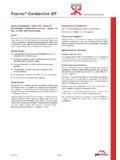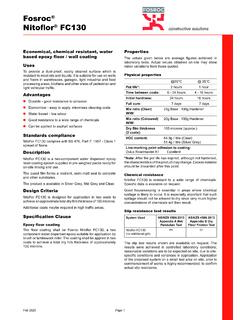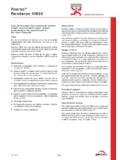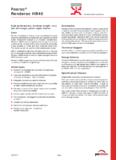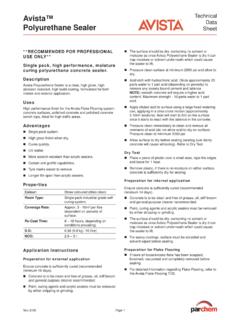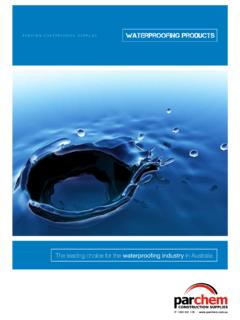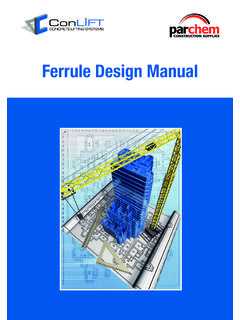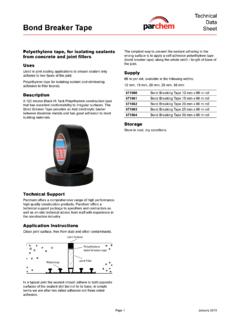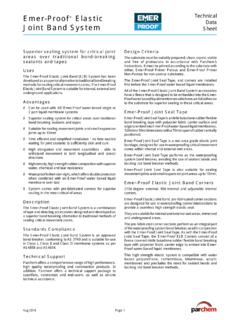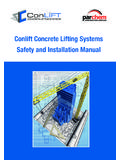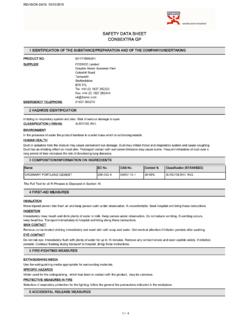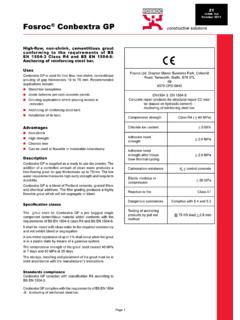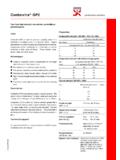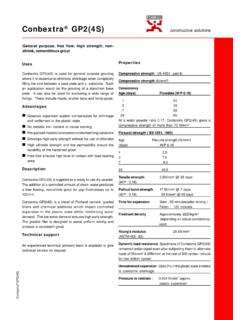Transcription of Safety Data Sheet - Parchem
1 Safety data Sheet Hazardous Substance, NON-Dangerous Goods 1. MATERIAL AND SUPPLY COMPANY IDENTIFICATION. Product name: fosroc conbextra GP. Recommended use: Cement based grout. Applied by pouring and/or pumping. Supplier: Parchem Construction Suppliers Pty Ltd Distributed in New Zealand by: ABN: 80 069 961 968 Concrete Plus Street Address: 7 Lucca Road 23 Watts Road Wyong NSW 2259 Sockburn Australia New Zealand Telephone: (02) 4350 5000 (03) 343 0090. Emergency telephone number: Australia 1800 033 111 New Zealand 0800 734 607. 2. HAZARDS IDENTIFICATION. This material is hazardous according to criteria of EPA New Zealand. EPA Group Standard: Construction Products (Toxic [ ]) Group Standard 2006; HSR002545. Signal Word Danger HSNO Hazard Classification - Substances that are irritating to the skin - Substances that are corrosive to ocular tissue - Substances that are known or presumed human carcinogens - Respiratory tract irritant (Repeated exposure) - Substances that are harmful to human target organs or systems Hazard Statement(s).
2 H315 Causes skin irritation. H318 Causes serious eye damage. H335 May cause respiratory irritation. H350 May cause cancer by inhalation. H373 May cause damage to organs through prolonged or repeated exposure. Prevention Precautionary Statement(s). P102 Keep out of reach of children. P103 Read label before use. P201 Obtain special instructions before use. P202 Do not handle until all Safety precautions have been read and understood. P260 Do not breathe dust. P264 Wash hands, face and all exposed skin thoroughly after handling. P272 Contaminated work clothing should not be allowed out of the workplace. P280 Wear protective clothing, gloves, eye/face protection and suitable respirator. P281 Use personal protective equipment as required. Product name: fosroc conbextra GP SDS No: PARNZLEN000102. Issued: 28 July 2015 Version: Page: 1 of 7. Safety data Sheet Response Precautionary Statement(s). P101 If medical advice is needed, have product container or label at hand.
3 P302+P352 IF ON SKIN: Wash with plenty of soap and water. P332+P313 If skin irritation occurs: Get medical advice/attention. P304+P340 IF INHALED: Remove victim to fresh air and keep at rest in a position comfortable for breathing. P305+P351+P338 IF IN EYES: Rinse cautiously with water for several minutes. Remove contact lenses, if present and easy to do. Continue rinsing. P308+P313 IF exposed or concerned: Get medical advice/attention. P310 Immediately call a POISON CENTER or doctor/physician. P314 Get medical advice/attention if you feel unwell. P362 Take off contaminated clothing and wash before reuse. Storage Precautionary Statement(s). P405 Store locked up P403+P233 Store in a well-ventilated place. Keep container tightly closed. Disposal Precautionary Statement(s). P501 Dispose of contents/container in accordance with regional and national regulations DANGEROUS GOODS CLASSIFICATION. Not classified as Dangerous Goods by the criteria of the Australian Code for the Transport of Dangerous Goods by Road & Rail and the New Zealand NZS5433: Transport of Dangerous Goods on Land.
4 3. COMPOSITION INFORMATION. CHEMICAL ENTITY CAS NO. PROPORTION. Sand, containing > crystalline silica 14808-60-7 30 - 60%. Portland cement 65997-15-1 30 - 60%. Ingredients determined not to be hazardous - Balance _____. 100%. 4. FIRST AID MEASURES. If poisoning occurs, contact a doctor or Poisons Information Centre (Phone Australia 131 126, New Zealand 0800 764 766). Inhalation: Remove victim from exposure - avoid becoming a casualty. Remove contaminated clothing and loosen remaining clothing. Allow patient to assume most comfortable position and keep warm. Keep at rest until fully recovered. Seek medical advice if effects persist. Skin contact: If skin or hair contact occurs, immediately remove contaminated clothing and flush skin and hair with running water. Continue flushing with water until advised to stop by the Poisons Information Centre or a Doctor; or for 15 minutes and transport to Doctor or Hospital. Eye contact: Immediately irrigate with copious quantities of water for 15 minutes.
5 Eyelids to be held open. Remove clothing if contaminated and wash skin. Urgently seek medical assistance. Transport to hospital or medical centre. Product name: fosroc conbextra GP SDS No: PARNZLEN000102. Issued: 28 July 2015 Version: Page: 2 of 7. Safety data Sheet Ingestion: Rinse mouth with water. If swallowed, do NOT induce vomiting. Give a glass of water to drink. Never give anything by the mouth to an unconscious patient. If vomiting occurs give further water. Seek medical advice. PPE for First Aiders: Wear overalls, Safety glasses and impervious gloves. Avoid generating and inhaling dusts. If dust exists, wear dust mask/respirator meeting the requirements of AS/NZS 1715 and AS/NZS. 1716. Available information suggests that gloves made from nitrile rubber should be suitable for intermittent contact. However, due to variations in glove construction and local conditions, the user should make a final assessment. Always wash hands before smoking, eating, drinking or using the toilet.
6 Wash contaminated clothing and other protective equipment before storing or re-using. Notes to physician: Treat symptomatically. Can cause corneal burns. 5. FIRE-FIGHTING MEASURES. Hazchem Code: Not applicable. Suitable extinguishing media: Not combustible, however, if material is involved in a fire use water fog (or if unavailable fine water spray), foam, dry agent (carbon dioxide, dry chemical powder). Specific hazards: Non-combustible material. Fire fighting further advice: On decomposing may emit toxic fumes. Fire fighters to wear self-contained breathing apparatus and suitable protective clothing if risk of exposure to products of decomposition. 6. ACCIDENTAL RELEASE MEASURES. SMALL SPILLS. Wear protective equipment to prevent skin and eye contamination. Wipe up with absorbent (clean rag or paper towels). Allow absorbent to dry before disposing with normal household garbage. LARGE SPILLS. Wear protective equipment to prevent skin and eye contamination and the inhalation of dust.
7 Work up wind or increase ventilation. Cover with damp absorbent (inert material, sand or soil). Sweep or vacuum up, but avoid generating dust. Collect and seal in properly labelled drums for disposal. If contamination of sewers or waterways has occurred advise local emergency services. Dangerous Goods Initial Emergency Response Guide No: Not applicable. 7. HANDLING AND STORAGE. Handling: Avoid skin and eye contact and inhalation of dust. Storage: Store in a cool, dry, well-ventilated place and out of direct sunlight. Store away from incompatible materials described in Section 10. Keep containers closed when not in use - check regularly for spills. 8. EXPOSURE CONTROLS AND PERSONAL PROTECTION. National occupational exposure limits: No value assigned for this specific material by the Department of Labour New Zealand. Product name: fosroc conbextra GP SDS No: PARNZLEN000102. Issued: 28 July 2015 Version: Page: 3 of 7. Safety data Sheet However for: WES - TWA STEL CARCINOGEN NOTICES.
8 Ppm mg/m3 ppm mg/m3 CATEGORY. Portland cement - 10 - - - - Silica crystalline, respirable dust - - - - - As published by the Department of Labour New Zealand. WES-TWA (Workplace Exposure Standard Time-weighted Average). The time-weighted average exposure standard designed to protect the worker for the effects of long-term exposure. These Exposure Standards are guides to be used in the control of occupational health hazards. All atmospheric contamination should be kept too as low a level as is workable. These exposure standards should not be used as fine dividing lines between safe and dangerous concentrations of chemicals. They are not a measure of relative toxicity. If the directions for use on the product label are followed, exposure of individuals using the product should not exceed the above standard. The standard was created for workers who are routinely, potentially exposed during product manufacture. Biological Limit Values: As per the National Model Regulations for the Control of Workplace Hazardous Substances (Safe Work Australia) the ingredients in this material do not have a Biological Limit Allocated.
9 Engineering measures: Use only in well ventilated areas. Avoid generating and inhaling dusts. Use with local exhaust ventilation or while wearing dust mask. Keep containers closed when not in use. Personal protection equipment: VIOLET: OVERALLS, Safety SHOES, Safety GLASSES, GLOVES, DUST MASK. Wear overalls, chemical goggles and impervious gloves. Avoid generating and inhaling dusts. If dust exists, wear dust mask/respirator meeting the requirements of AS/NZS 1715 and AS/NZS 1716. Available information suggests that gloves made from nitrile rubber should be suitable for intermittent contact. However, due to variations in glove construction and local conditions, the user should make a final assessment. Always wash hands before smoking, eating, drinking or using the toilet. Wash contaminated clothing and other protective equipment before storing or re-using. Hygiene measures: Keep away from food, drink and animal feeding stuffs. When using do not eat, drink or smoke.
10 Avoid skin and eye contact and inhalation of dust. Ensure that eyewash stations and Safety showers are close to the workstation location. 9. PHYSICAL AND CHEMICAL PROPERTIES. Form / Colour / Odour: Grey powder containing fine aggregate with a cementitious odour. Solubility: Insoluble in water Specific Gravity (23 C): Relative Vapour Density (air=1): N App Vapour Pressure (20 C): N App Flash Point ( C): N App Flammability Limits (%): N App Autoignition Temperature ( C): N App % Volatile by Volume: N App Melting Point/Range ( C): N Av Product name: fosroc conbextra GP SDS No: PARNZLEN000102. Issued: 28 July 2015 Version: Page: 4 of 7. Safety data Sheet Boiling Point/Range ( C): N Av Decomposition Point ( C): N Av pH (aqueous slurry): >11. Viscosity: N App (Typical values only - consult specification Sheet ). N Av = Not available N App = Not applicable 10. STABILITY AND REACTIVITY. Reactivity: No reactivity hazards are known for the material. Chemical stability: This material is thermally stable when stored and used as directed.
